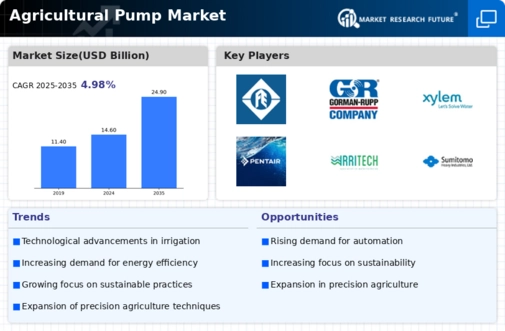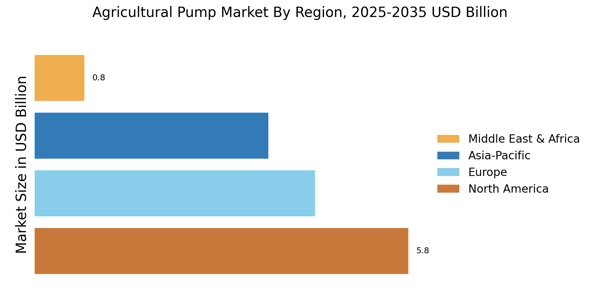The Agricultural Pump Market is currently characterized by a dynamic competitive landscape, driven by increasing demand for efficient irrigation solutions and sustainable agricultural practices. Key players such as Netafim (IL), Valmont Industries (US), and Jain Irrigation Systems (IN) are strategically positioning themselves through innovation and regional expansion. Netafim, for instance, focuses on precision irrigation technologies, which align with the growing emphasis on water conservation. Valmont Industries emphasizes its commitment to sustainability, integrating advanced technologies into its product offerings, thereby enhancing its competitive edge. Collectively, these strategies not only foster innovation but also contribute to a more sustainable agricultural ecosystem, shaping the market's competitive environment.
In terms of business tactics, companies are increasingly localizing manufacturing to reduce costs and enhance supply chain efficiency. This approach appears to be particularly relevant in a moderately fragmented market, where the collective influence of key players is significant. The competitive structure allows for both established firms and emerging players to coexist, fostering a diverse range of products and solutions tailored to various agricultural needs. As such, the market is witnessing a blend of traditional practices and modern technological advancements, which are crucial for meeting the evolving demands of farmers worldwide.
In August 2025, Jain Irrigation Systems (IN) announced a strategic partnership with a leading agri-tech firm to develop smart irrigation solutions. This collaboration is poised to enhance Jain's product portfolio, integrating IoT technologies that enable real-time monitoring and management of irrigation systems. The strategic importance of this partnership lies in its potential to position Jain as a frontrunner in the smart agriculture segment, catering to the increasing demand for data-driven farming solutions.
Similarly, in September 2025, Valmont Industries (US) launched a new line of solar-powered pumps aimed at enhancing energy efficiency in irrigation. This initiative not only underscores Valmont's commitment to sustainability but also addresses the rising energy costs faced by farmers. By leveraging renewable energy sources, Valmont is likely to attract environmentally conscious consumers, thereby strengthening its market position.
In October 2025, Netafim (IL) unveiled its latest precision irrigation system, which utilizes AI algorithms to optimize water usage based on real-time weather data. This innovation reflects a broader trend towards digitalization in agriculture, where technology plays a pivotal role in enhancing productivity and resource management. The introduction of such advanced systems may significantly alter competitive dynamics, as companies that fail to adapt to these technological advancements could find themselves at a disadvantage.
As of October 2025, the Agricultural Pump Market is increasingly defined by trends such as digitalization, sustainability, and the integration of artificial intelligence. Strategic alliances are becoming more prevalent, as companies recognize the need to collaborate in order to innovate and meet the demands of a rapidly evolving market. Looking ahead, competitive differentiation is likely to shift from traditional price-based competition to a focus on innovation, technology, and supply chain reliability. This evolution suggests that companies that prioritize these aspects will be better positioned to thrive in the future.


















Leave a Comment